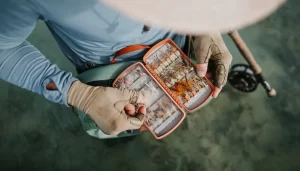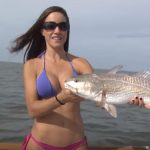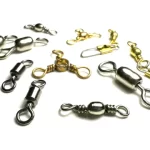Assembling a fly-fishing kit is a crucial step in preparing for a successful day on the water. The process of curating a personalized terminal tackle kit depends on several factors, including location, target species, and fishing conditions. Below is a comprehensive guide to stocking the essentials for a versatile and efficient fly-fishing setup.
Selecting the Right Tackle Box or Bag
The first decision involves choosing the best way to store and carry equipment. Traditional tackle boxes work well for boat fishing, while bags, backpacks, or sling packs are often better for anglers who cover significant ground. Comfort and accessibility should be priorities, as gear should remain organized without interfering with movement or casting.
Recommendations:
- Tackle Boxes: Yeti Loadout® GoBox 15, Simms Fishing 20L Dry Creek Boat Bag.
- Backpacks: Wild River Backpack With Fly Boxes, Fishpond Green River Gear Bag.
- Sling Packs: Fishpond Thunderhead Submersible Sling, Orvis Sling Pack.

Stocking Flies for Success
A well-rounded selection of flies is essential. Most freshwater anglers should carry:
- Dry Flies: Designed to float on the surface, mimicking insects.
- Nymphs: Subsurface flies that imitate aquatic insects or larvae.
- Streamers: Larger flies resembling baitfish, best used with active line retrieval techniques.
Local fly shops provide valuable advice on the most effective patterns for specific waters and fish species.
Keeping Flies Organized
Fly boxes are the best way to protect and organize flies. Look for designs that seal out moisture and securely hold flies in place. Foam-lined boxes are common, while silicone inserts provide added durability.
Top Picks:
- MaximumCatch Two-Sided Fly Fishing Box
- Orvis Ultralight Foam Box
Essential Line Components: Tippet and Leader
The leader connects the fly line to the fly, while the tippet extends the leader’s life by replacing worn sections. Sizes vary based on target species, with finer diameters offering better presentation but reduced strength. Trout fishing often requires sizes ranging from 3X to 6X.
Must-Have Tools
- Nippers: For trimming tippet and leader material.
- Fishing Pliers: Useful for handling fish and removing hooks without causing harm.
Recommended Tools:
- Orvis Comfy Grip Nippers
- KastKing Cutthroat 7-inch Pliers
Additional Accessories
Several optional items can enhance the fly-fishing experience:
- Tippet Bars: For organizing tippet spools.
- Flotants: Gels or powders used to keep flies buoyant.
- Split Shot: Small weights for sinking flies to desired depths.
- Indicators: Floating markers that suspend flies at specific depths.
Polarized sunglasses are essential for reducing glare and improving visibility while providing protection from stray hooks.
Adapting for Specific Fisheries
Fly-fishing gear should be tailored to the intended fishing environment:
Saltwater Fly Fishing:
- Use tropical or cold-water lines based on location.
- Prioritize corrosion-resistant pliers and rinse gear after use.
- Bring sun protection, such as reef-safe sunscreen and face coverings.
Trout Fly Fishing:
- Equip a 4-, 5-, or 6-weight rod.
- Stock fly boxes with topwater patterns like stimulators and caddis flies.
Bass and Warm-Water Species:
- Include larger flies, such as streamers and foam poppers.
- Opt for stiffer rods to handle heavier lures and stronger strikes.
Embracing Trial and Error
Experimentation is key to building the perfect fly-fishing kit. Borrowing gear, consulting local experts, and testing different setups will help refine equipment choices. Over time, the tackle box will reflect both functional needs and personal preferences.
Fishing gear is meant to be used, so head to the water and put every carefully selected item to work. Each trip offers new lessons, making the process of building a kit an enjoyable part of the journey.
Image/Source: WOS





